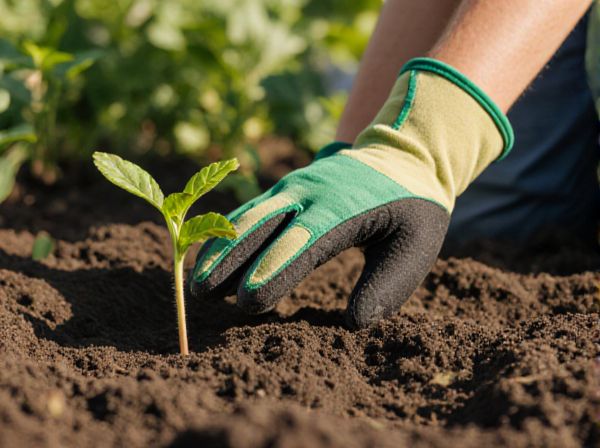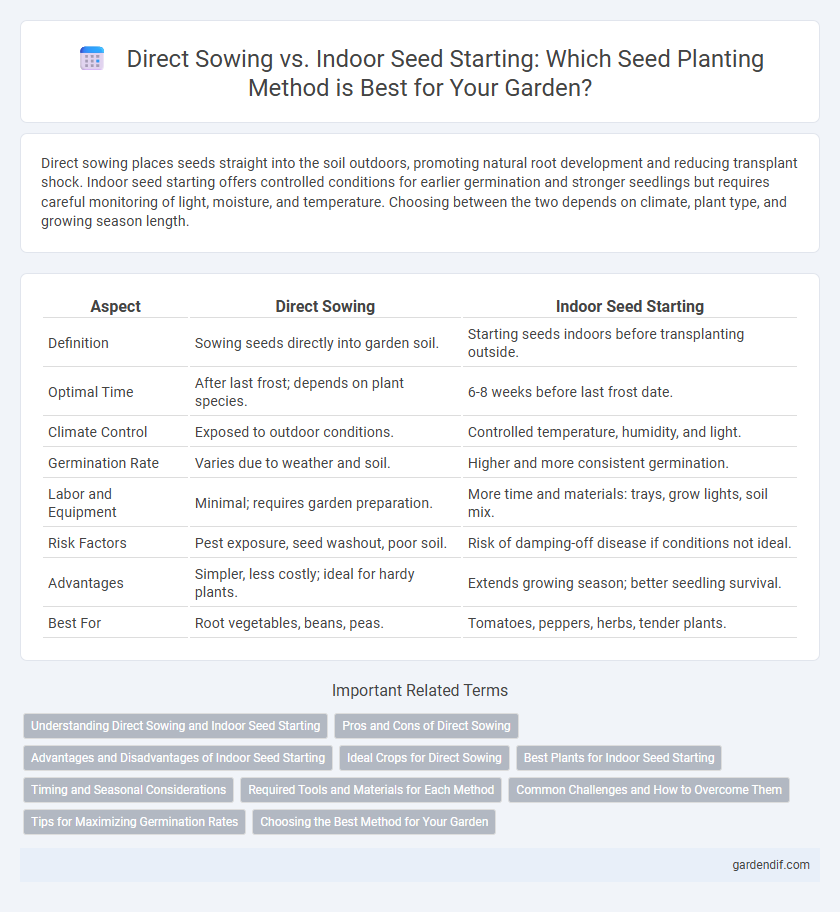
Direct sowing vs Indoor seed starting Illustration
Direct sowing places seeds straight into the soil outdoors, promoting natural root development and reducing transplant shock. Indoor seed starting offers controlled conditions for earlier germination and stronger seedlings but requires careful monitoring of light, moisture, and temperature. Choosing between the two depends on climate, plant type, and growing season length.
Table of Comparison
| Aspect | Direct Sowing | Indoor Seed Starting |
|---|---|---|
| Definition | Sowing seeds directly into garden soil. | Starting seeds indoors before transplanting outside. |
| Optimal Time | After last frost; depends on plant species. | 6-8 weeks before last frost date. |
| Climate Control | Exposed to outdoor conditions. | Controlled temperature, humidity, and light. |
| Germination Rate | Varies due to weather and soil. | Higher and more consistent germination. |
| Labor and Equipment | Minimal; requires garden preparation. | More time and materials: trays, grow lights, soil mix. |
| Risk Factors | Pest exposure, seed washout, poor soil. | Risk of damping-off disease if conditions not ideal. |
| Advantages | Simpler, less costly; ideal for hardy plants. | Extends growing season; better seedling survival. |
| Best For | Root vegetables, beans, peas. | Tomatoes, peppers, herbs, tender plants. |
Understanding Direct Sowing and Indoor Seed Starting
Direct sowing involves planting seeds directly into the garden soil, allowing natural conditions to stimulate germination and growth, which suits crops like carrots and beans that dislike transplanting. Indoor seed starting offers controlled temperature, light, and moisture, promoting early germination for sensitive or slow-growing plants such as tomatoes and peppers. Understanding the benefits of each method helps optimize plant development and improve overall garden yields.
Pros and Cons of Direct Sowing
Direct sowing seeds outdoors eliminates the need for transplanting, which reduces root disturbance and helps plants establish stronger root systems. It is cost-effective and saves time since seeds are planted directly in their growing environment, but the downside includes vulnerability to weather fluctuations, pests, and slower germination compared to indoor seed starting. Direct sowing is ideal for hardy plants that tolerate outdoor conditions well, yet it may result in uneven germination and lower initial growth rates.
Advantages and Disadvantages of Indoor Seed Starting
Indoor seed starting offers greater control over temperature, moisture, and light conditions, promoting higher germination rates and healthier seedlings compared to direct sowing. It allows for an extended growing season, enabling gardeners to start plants earlier indoors before transplanting outdoors. However, indoor seed starting can require more time, equipment, and attention to avoid issues like damping-off disease and leggy seedlings.
Ideal Crops for Direct Sowing
Direct sowing is ideal for root vegetables like carrots, beets, and radishes, as well as leafy greens such as spinach and lettuce, which develop strong root systems without transplant shock. Beans, peas, and corn thrive when planted directly into warm soil, promoting robust growth and higher yields. Hardy herbs like dill, cilantro, and basil also benefit from direct sowing, ensuring steady germination and natural acclimation to outdoor conditions.
Best Plants for Indoor Seed Starting
Tomatoes, peppers, and herbs like basil thrive with indoor seed starting due to their long growing seasons and need for controlled temperature and light conditions. Leafy greens such as lettuce and spinach can also benefit from indoor sowing to ensure early, strong seedlings before transplanting. Starting these plants indoors promotes healthier, more vigorous seedlings compared to direct sowing, especially in regions with shorter frost-free periods.
Timing and Seasonal Considerations
Direct sowing is ideal for seeds that thrive in warmer soil temperatures and can tolerate outdoor conditions once the danger of frost has passed, typically in late spring. Indoor seed starting allows gardeners to get a head start by planting seeds 6-8 weeks before the last expected frost date, ensuring seedlings are strong enough for transplanting when outdoor conditions become favorable. Understanding regional frost dates and soil temperatures is crucial to optimizing timing and maximizing seed germination success.
Required Tools and Materials for Each Method
Direct sowing requires minimal tools, typically including quality garden soil, seed packets suited for outdoor planting, a garden trowel or dibber, and watering equipment such as a hose or watering can with a fine nozzle. Indoor seed starting demands more specialized materials, including seed trays or pots with drainage holes, sterile seed-starting mix to prevent disease, grow lights or a sunny windowsill for adequate light, humidity domes to maintain moisture, heat mats to provide consistent warmth, and labels to track different seed varieties. Each method's tool requirements reflect the growing environment, where direct sowing relies on natural conditions and basic gardening gear, while indoor seed starting leverages controlled conditions for optimal germination and seedling development.
Common Challenges and How to Overcome Them
Direct sowing often faces challenges such as uneven germination and poor seedling survival due to environmental factors like heavy rainfall or pests. Indoor seed starting can encounter issues with damping-off disease and insufficient light, which can be mitigated by using sterile soil mixes and providing grow lights. To overcome these obstacles, gardeners should select disease-resistant seed varieties, maintain consistent moisture levels, and monitor temperature and humidity to create optimal growing conditions both indoors and outdoors.
Tips for Maximizing Germination Rates
For maximizing germination rates, direct sowing benefits from soil temperature monitoring and adequate moisture levels to ensure seeds sprout quickly in natural conditions. Indoor seed starting requires maintaining consistent warmth between 65-75degF and using a humidity dome to create a greenhouse effect that accelerates seedling growth. Both methods improve success by selecting high-quality, fresh seeds and avoiding planting too deeply, typically no more than twice the seed's diameter.
Choosing the Best Method for Your Garden
Choosing between direct sowing and indoor seed starting depends on plant type, climate, and garden space. Direct sowing suits hardy crops like beans and carrots, ensuring strong root systems and minimal transplant shock. Indoor seed starting benefits tender plants such as tomatoes and peppers by providing controlled temperatures and early germination, leading to an extended growing season and higher success rates.
Direct sowing vs Indoor seed starting Infographic

 gardendif.com
gardendif.com